
 |
| About Fogarty |
|
||||||||||||||||||||||||||||||||||||||||||||||||||||||||||||||||||||||||||||||||||||||||||||||||||||||||||||||||||||||||||||||||||||||||||||||||||||||||||||||||||||||||||||||||||||||||||||||||||||||||||||||||||||||||||||||||||||||||||||||||||||||||||||||||||||||||||||||||||||||||||||||||||||||||||||||||||||||||||||||||||||||||||||||||||||||||||||||||||||||||||||||||||||||||||||||||||||||||||||||||||||||||||||||||||||||||||||||||||||||||||||||||||||||||||||||||||||||||||||||||||||||||||||||||||||||||||||||||||||||||||||||||||||||||||||||||||||||||||||||||||||||||||||||||||||||||||||||||||||||||||||||||||||||||||||||||||||||||||||||||||||||||||||||||||||||||||||||||||||||||||||||||||||||||||||||||||||||||||||||||||||||||||||||||||||||||||||||||||||||||||||||||||||||||||||||||||||||||||||||||||||||||||||||||||||||||||||||||||||||||||||||||||||||||||||||||||||||||||||||||||||||||||||||||||||||||||||||||||||||||||||||||||||||||||||||||||||||||||||||||||||||||||||||||||||||||||||||||||||||
FIC FY2008 Congressional JustificationTable of Contents
FY 2008 Proposed Appropriation Language:For carrying out section 301 and title IV of the Public Health Services Act with respect to the activities at John E. Fogarty International Center $66,594,000. (Department of Health and Human Services Appropriation Act, 2006) Amounts Available for Obligation *
* Excludes the following amounts for reimbursable activities carried out by this account: FY 2006 - $2,299,000; FY 2007 - $4,800,000; FY 2008 - $4,815,000 Budget Mechanism - Total(Dollars in thousands)
Includes FTEs which are reimbursed from the NIH Roadmap for Medical Research. Budget Authority by Program(Dollars in thousands)
Includes FTEs which are reimbursed from the NIH Roadmap for Medical Research Back to top Major Changes in the Fiscal Year 2008 Budget RequestMajor changes by budget mechanism and/or budget activity detail are briefly described below. Note that there may be overlap between budget mechanism and activity detail and these highlights will not sum to the total change for the FY 2008 budget request for John E. Fogarty International Center (FIC) which is $0.2 million more than the FY 2007 Continuing Resolution, for a total of $66.6 million. Research Project Grants (+$0.1 million; total $14.4 million): FIC will support a total of 190 Research Project Grant (RPG) awards in FY 2008. Noncompeting RPGs will increase by one award and decrease by -$1.5 million. Competing RPGs will increase by seven awards and increase by $1.6 million. Research Careers (+$0.2 million; total $1.8 million): FIC will support the Pathway to Independence program by funding an additional two awards in FY 2008. Total support for the Pathway program in FY 2008 is four awards and $0.4 million. NIH Roadmap for Biomedical Research (+$0.1 million; total $0.9 million): FIC will continue its support of the NIH Roadmap, an incubator for new ideas and initiatives that will accelerate the pace of discovery, in FY 2008. Research Capacity Strengthening: Institutional Capacity Building (-$0.2 million; total $33.8 million): FIC will reduce slightly the funding level for emerging infectious disease programs. Research Capacity Strengthening: Development of Human Resources for Global Health Research (+$0.2 million; total $3.5 million): FIC will support the Pathway to Independence program by funding an additional two awards in FY 2008. Total support of the Pathway program in FY 2008 is four awards and $0.4 million. Summary of Changes
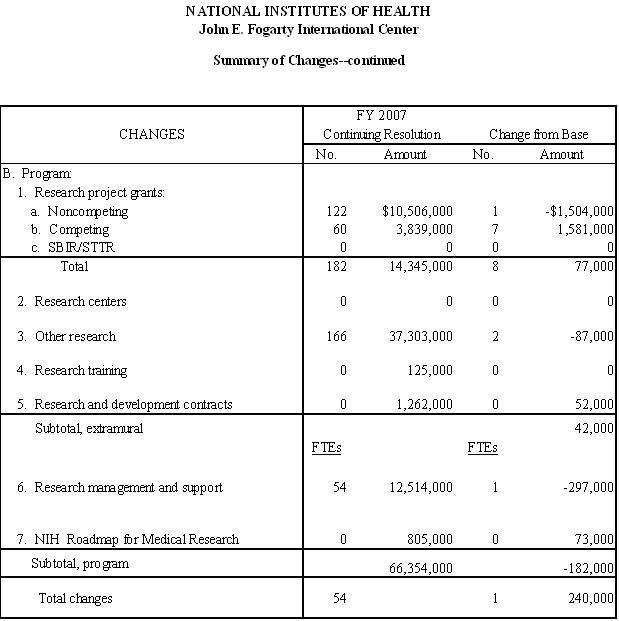
Fiscal Year 2008 Budget GraphsHistory of Budget Authority and FTEs: 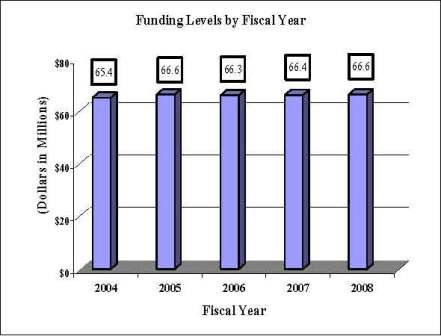 [Fig. 1] [Fig. 1]
 [Fig. 2]
[Fig. 2]
Distribution by Mechanism: 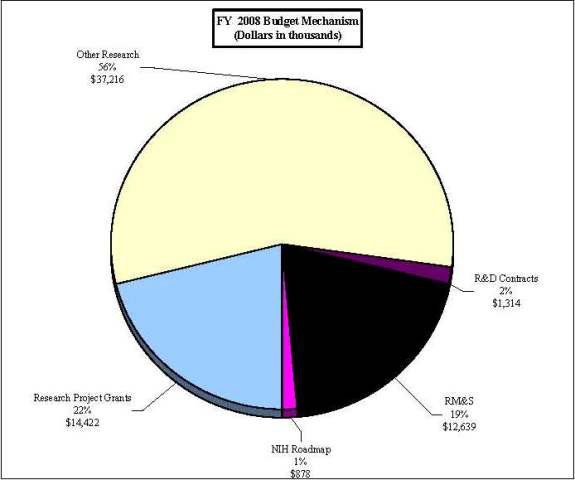 [Fig. 3] [Fig. 3]
Change by Selected Mechanisms: 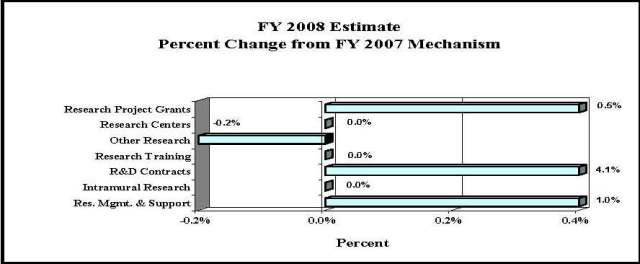 [Fig. 4] [Fig. 4]
Back to top JustificationAuthorizing Legislation: Sections 301 and 307 and Title IV of the Public Health Service Act, as amended.
This document provides justification for the Fiscal Year (FY) 2008 activities of the Fogarty International Center (FIC); including HIV/AIDS activities. Details of the FY 2008 HIV/AIDS activities are in the "Office of AIDS Research (OAR)" Section of the Overview. Details of the Roadmap/Common Fund are located in the Overview, Volume One. DIRECTOR'S OVERVIEW"The NIH speaks the universal language of humanitarianism. It has been devoted throughout its long and distinguished history to furthering the health of all mankind, in which services it has recognized no limitations imposed by international boundaries; has recognized no distinctions of race, of creed, or of color." Franklin D. Roosevelt The Fogarty International Center plays a critical and unique role in promoting better health around the globe. Specifically, it strengthens human and institutional capacity to confront complex global health challenges in two ways. First, Fogarty’s innovative training programs build the knowledge and skills of developing country foreign scientists to perform health research in their countries and collaborate as full and effective partners for U.S. scientists. Second, it is investing in the next generation of U.S. scientific leaders in global health research. Fogarty also identifies crucial gaps in global health research and supports international research collaborations. This helps U.S. scientists maintain their competitive lead. Research Training. Infectious diseases continue to exact an enormous toll on millions of people in developing countries. HIV/AIDS, TB and malaria constitute a triple threat in many developing countries and collectively kill over six million people each year.[1] In July 2006, the G-8 nations made a landmark decision to join in the fight against infectious diseases. They pledged to: "...increase scientific cooperation with developing countries, encourage partnerships between experts and laboratories of developing and developed countries, and increase the scientific potential in countries of all income levels... By expanding ties with developing countries institutions for the application of research findings in those countries, we can help prepare the current and future generations of scientists in developing countries to function and excel in a global environment."[2] For many years, Fogarty programs have trained thousands of scientists in developing countries. This expertise now allows researchers and research institutions to contribute to the success of recent investments made by Congress, particularly through the President’s Emergency Plan for AIDS Relief (PEPFAR), the Global Fund to Fight AIDS, TB and Malaria, and the President’s Malaria Initiative (PMI). For example, clinical trials for new malaria vaccines or TB drugs must be conducted in endemic areas, requiring local scientists to participate in the design, conduct and analysis of these trials. Long-term success of U.S. and multilateral investments also depends on the ability to conduct research abroad to identify how to best deliver preventive services and treatment for multiple infections in low-resource settings. As a result of Fogarty’s long-term infectious disease research investment, its trainees are on the front lines to prevent, identify, and contain emerging infectious diseases such as SARS and avian influenza. Developing the next generation of U.S. leaders in global health research. With a growing interest in global health in U.S. universities, Fogarty is providing the leadership to sustain and capitalize on this energy. A new generation of Americans is committed to improving global health through research. Fogarty is providing a launching pad for American students and junior researchers to build relationships abroad and to address critical research relevant questions about global health to both the U.S. and the developing world. Research. Fogarty’s research portfolio targets strategic areas vital to promoting global health. For example, mental, neurological, and behavioral disorders collectively affect more than 450 million people worldwide.[3] In response to this growing burden, Fogarty and its NIH partners support collaborative research and training between American scientists and their developing country counterparts. Insights generated will lead to better treatment and health care delivery here and abroad. Another example is Fogarty’s Stigma and Global Health Research Program, which is generating new evidence on the causes, consequences and effective interventions for stigma-related barriers concerning HIV/AIDS, mental health, and other areas. Looking forward. Fogarty is developing a Strategic Plan that will guide our priorities from FY 2007 – FY 2011. We anticipate and are addressing changing trends in the global burden of disease and evolving research needs. For example, to support implementation of the PMI, Fogarty will fund planning grants for clinical, operational and health services research training in PMI countries for FY 2007 - FY 2008. Another example reflects the increasing global burden of cancer and cardiovascular diseases due to smoking, as Fogarty is recompeting its International Tobacco and Health Research and Capacity Building Program in FY 2007. To enhance its investment in the next generation of U.S. leaders in global health research, Fogarty will expand its International Clinical Research Scholars program in FY 2008 by providing additional support during the scholars’ medical residency and fellowship programs. Fogarty also plans to provide leadership in international “implementation science,” which is the translation and scale up of health innovations into effective new public health programs. Fogarty has historically considered the needs of other NIH Institutes, Centers and Offices (ICs) in the development of its programs, and has collaborated with almost every IC over the past five years. We will continue to do this as we plan for the future. British medical journal The Lancet recently noted that “Health is now the most important foreign policy issue of our time.” In an era of global interconnectedness, science’s role in diplomacy is critical. Fogarty creates opportunities for scientists, research institutions and governments to bridge differences between countries while building trust and lasting collaborations. Such partnerships can provide hope; address health disparities within countries or regions; and promotes stability, goodwill and peace. On behalf of the NIH, Fogarty plays a vital role in facilitating these international partnerships. Back to top FY 2007 Justification by Activity Detail Research Capacity StrengtheningInstitutional Capacity Building: FIC supports eleven research training programs, each designed to enhance research capacity in an area of critical importance to the health of people who live in resource-poor settings. Cognizant that it takes many years to build sustainable and robust capacity to conduct global health research, each program takes a long-term approach and provides training at a U.S. academic institution for a succession of junior investigators from a foreign institution. Training must be clearly linked to funded research activities usually supported by the NIH. This requirement is common to all FIC research training programs, which build upon and enhance the international research activities of other ICs and enable research institutions and scientists in developing countries to be effective long-term international partners in global health research. Fogarty also invests in cross-cutting infrastructure to support the ethical conduct of research and the ability to utilize information technology resources optimally. To bolster this institutional capacity, Fogarty supports an international bioethics training program to build a cadre of developing country professionals qualified to conduct ethical reviews of clinical investigations locally. Fogarty’s informatics training program is increasing the capacity of developing country scientists to design, access and use information technology in support of health sciences research. Budget Policy: The 2008 budget estimate for Institutional Capacity Building is $33,846,000, a decrease of $215,000 or -0.6 percent from the FY 2007 Continuing Resolution. The program plans for 2008, along with expected outputs are as follows:
Portrait of a Program: Strengthening Capacity in Infectious Diseases ResearchFY 2007 Level: $21,606,000 Robust local research capacity is essential to ensuring that the benefits of the PEPFAR, the Global Fund, and PMI are achieved. Fogarty’s AIDS International Training and Research Program (AITRP) responds to the demand for in-country research and public health capacity to effectively deal with the expanding HIV/AIDS epidemic. For example, as one of PEPFAR’s focus countries, Zambia has received a significant amount of recent attention due to its early success in scale-up of antiretroviral therapy (ART) for its HIV/AIDS-infected population. In part, this success is a result of the AITRP, which has allowed the University of Alabama to provide long-term degree training to 22 Zambian research scientists, all of whom have returned home and are working in HIV/AIDS and health development, either as researchers, educators, or program leaders for institutions such as the CDC, UNICEF, and the WHO. FIC’s International Clinical, Operational, and Health Services Research Training Award for AIDS and TB (ICOHRTA-AIDS/TB) is a newer effort that strengthens the ability of foreign scientists and their institutions to conduct collaborative clinical, operational, and health services research with U.S. scientists in the context of HIV/AIDS and TB. These investments help countries to identify effective interventions specific to local needs and better implement successful interventions and scale-up of treatment and care through the local health care system. For example, Haiti’s ICOHRTA-AIDS/TB research training program is designed specifically to provide training for monitoring and evaluation for the scale-up of HIV prevention and care services supported by PEPFAR and the Global Fund. To support the implementation of the PMI, to provide sustainable scientific capacity to address the challenges of malaria control, and to rapidly move malaria research results into practice, FIC plans to duplicate the ICOHRTA-AIDS/TB model for malaria for PMI countries. Research on new TB technologies is of particular importance given the recent emergence of extensively drug resistant TB, which is unresponsive to first- and second-line drugs and could pose a serious threat to populations around the world. Supported by a FIC Global Infectious Disease research grant to the University of Cape Town in South Africa, clinical research team members are being trained in collaboration with The George Washington University to conduct trials of new drugs and vaccines such as TB vaccines developed by Aeras with support from the Gates Foundation. Development of Human Resources for Global Health Research: FIC is committed to ensuring that U.S. junior scientists and clinicians have opportunities to engage in international research early in their careers. Through two specific programs - the International Clinical Research Scholars Program and the International Research Scientist Development Award - FIC fosters future U.S. leaders in global health research committed to confronting global health challenges, and who understand the realities of conducting research in resource-limited settings. By investing in these junior scientists, FIC is accomplishing two central objectives: attracting new research talent to global health research and advancing the career paths of exceptional junior U.S. scientists who can address critical health issues of developing country and U.S. populations. Budget Policy: The 2008 budget estimate for Development of Human Resources for Global Health Research is $3,512,000, an increase of $180,000 or 5.1 percent from the FY 2007 Continuing Resolution. The program plans for 2008, along with expected outputs are as follows:
Portrait of a Program: Investing in Future U.S. Global Health ScientistsFY 2007 Level: $2,308,000 Established in FY 2003 in partnership with the Ellison Medical Foundation, the Fogarty International Clinical Research Scholars Program (ICRSP) responds to the acute need for future clinical investigators who can translate basic research advances into clinical care on a global scale. This next generation of clinical researchers will require hands-on experience in conducting clinical trials and clinical research in countries where the disease burdens are highest, typically in poorer countries. The ICRSP provides highly motivated U.S. graduate students in the health sciences the opportunity to experience one year of mentored clinical research training at distinguished research institutions in developing countries. Current training sites include Bangladesh, Botswana, Brazil, China, Haiti, India, Kenya, Mali, Peru, Russia, South Africa, Tanzania, Thailand, Uganda, and Zambia. Since its inception, the program has supported 70 U.S. scholars. After the year of research training abroad, however, these fellows are often not provided with any resources or opportunities to capitalize on their experiences and pursue their long-term interests in clinical research and global health. This expansion will more effectively enlarge the pool of future U.S. leaders with the necessary skills needed to design and conduct research on critical global health problems in collaboration with developing country researchers. Through the International Research Scientist Development Award (IRSDA), FIC provides research support to U.S. postdoctoral scientists in the formative stages of their careers to solidify their commitment to global health research. Each IRSDA grantee works closely with an established developing country scientist and a U.S. mentor involved in collaborative research and training at both the developed and developing country institutions. These awards forge long-term partnerships between senior developing country researchers and outstanding U.S. junior scientists, who are the potential future leaders in global health research. Back to top International Collaborative ResearchFIC provides leadership by identifying critical areas of research that are not being adequately addressed by other research funding agencies or institutions, but that must be conducted to confront current and future global health challenges. These programs build long-term research collaborations between U.S. and foreign investigators in areas of mutual scientific interest, as well as including a research training aspect. They also bring together scientists of diverse disciplines. For example, Fogarty’s Ecology of Infectious Diseases research program funds interdisciplinary research projects that develop predictive models and principles governing the transmission dynamics of infectious disease agents. Benefits of the program include an increased capacity to forecast outbreaks and improved understanding of how diseases emerge and re-emerge, and strategies to control them. Under Fogarty’s International Cooperative Biodiversity Groups program, seven Groups of universities, environmental organizations and pharmaceutical companies in nine countries are currently collaborating on multi-disciplinary projects. Projects include acquisition and analysis of natural products as potential therapeutic agents for diseases such as HIV/AIDS, malaria, TB and other infectious diseases, cancers, heart disease, drug addiction and central nervous system disorders, including Alzheimer's disease. Budget Policy: The 2008 budget estimate for International Collaborative Research is $15,719,000, an increase of $77,000 or 0.5 percent from the FY 2007 Continuing Resolution. The program plans for 2008, along with expected outputs are as follows:
Portrait of a Program: International Research on Tobacco and HealthFY 2007 Level: $1,439,000 Worldwide, tobacco is estimated to kill about five million people annually. The 21st century is likely to see one billion tobacco deaths, most of them in low-income countries (Jha P., Chaloupka FJ, Moore J, et al., “Tobacco Addiction,” Disease Control Priorities in Developing Countries (2nd Edition 2006)), comprising America’s efforts to promote productivity and economic development in low- and middle- income countries. In addition to the health care costs that result from treating tobacco-related illness, morbidity and mortality from tobacco affect people at the height of their productivity, depriving families of much-needed income and draining workforces of countries around the globe. Recognizing the critical role of research in reducing the burden of tobacco use in low- and middle-income nations, FIC, in collaboration with the National Cancer Institute, the National Institute on Drug Abuse and other NIH ICs, established the International Tobacco and Health Research and Capacity Building Program in FY 2002. This program addresses the need to generate a solid evidence base that can inform effective tobacco control strategies and policies. It also supports the training necessary to create future capacity for tobacco research. The overwhelming majority of smokers begin tobacco use before they reach adulthood; therefore, the program emphasizes research on the determinants of youth smoking in diverse cultural and economic settings and on effective ways to prevent young people from starting to smoke. Grantees have also created a global network of scientists by forging new partnerships and collaborations with researchers in South America, the Middle East, Africa, Russia, and Asia. This network shares best practices, challenges, and opportunities related to research on the health aspects of tobacco use. Training of the next generation of scientists is a core feature of this program, and projects are required to include significant capacity and infrastructure-strengthening components. More than 1,600 individuals have already received research training under the program through long-term mentorship, meeting and workshop support, and support for short courses. Research Management and Support (RMS)FIC RMS activities provide administrative, budgetary, logistical, and scientific support in the review, award, and monitoring of research grants, training awards and research and development contracts. RMS functions also encompass strategic planning, coordination, and evaluation of the Center’s programs, regulatory compliance, international coordination, international science policy issues, and liaison with other Federal agencies, Congress, and the public. RMS includes the FIC’s in-house epidemiology and mathematical modeling of infectious diseases program, which includes primary concentrations on cross-national studies of mortality patterns with special emphasis on influenza-associated disease, vector borne, and vaccine preventable diseases. RMS also supports the staff that works on behalf of the FIC and NIH in developing new partnerships between U.S. scientists and institutions and counterparts abroad to advance research and training in the biomedical and behavioral sciences, and in identifying opportunities for collaboration with foreign science funding agencies. Budget Policy: The 2008 budget estimate for Research Management and Support is $12,639,000, an increase of $125,000 or 1.0 percent from the FY 2007 Continuing Resolution. The increase will support pay increases and other administrative activities. Back to top Budget Authority by Object
Includes FTEs which are reimbursed from the NIH Roadmap for Medical Research Salaries and Expenses
Back to top Authoring Legislation
Appropriations History
1/ Reflects enacted supplementals, rescissions, and reappropriations. 2/ Excludes funds for HIV/AIDS research activities consolidated in the NIH Office of AIDS Research 3/ Reflects a decrease of $60,000 for the budget amendment for Biodefense. 4/ Reflects a decrease of $292,000 for the budget amendment for Buildings and Facilities. 5/ Annualized current rate Details of Full-Time Equivalent Employment (FTEs)
Back to top Detail of Positions
Includes FTEs which are reimbursed from the NIH Roadmap for Medical Research. New Positions Requested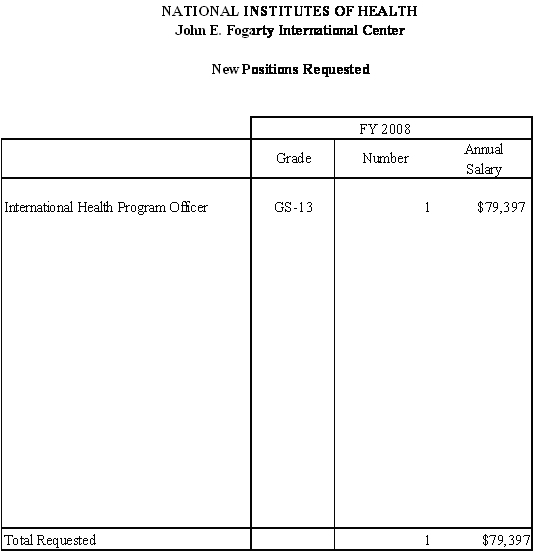 Back to top
[1] The Global Fund to Fight AIDS, Tuberculosis and Malaria, Monthly Progress Update, Nov. 15, 2006. [2] G-8 Summit 2006, St. Petersburg, Russia. [3] WHO website: http://www.who.int/mental_health/en/. Graphs1. Funding Levels by Fiscal Year(Dollars in Millions)
2. FTEs by Fiscal Year
3. FY 2008 Budget Mechanism(Dollars in thousands)
4. FY 2008 Estimate Percent Change from FY 2007 Mechanism
Research Project Grants
0.5%
Research Centers
0.0%
Other Research
-0.2%
Research Training
0.0%
R&D Contracts
4.1%
Intramural Research
0.0%
Res. Management & Support
1.0%
|
|||||||||||||||||||||||||||||||||||||||||||||||||||||||||||||||||||||||||||||||||||||||||||||||||||||||||||||||||||||||||||||||||||||||||||||||||||||||||||||||||||||||||||||||||||||||||||||||||||||||||||||||||||||||||||||||||||||||||||||||||||||||||||||||||||||||||||||||||||||||||||||||||||||||||||||||||||||||||||||||||||||||||||||||||||||||||||||||||||||||||||||||||||||||||||||||||||||||||||||||||||||||||||||||||||||||||||||||||||||||||||||||||||||||||||||||||||||||||||||||||||||||||||||||||||||||||||||||||||||||||||||||||||||||||||||||||||||||||||||||||||||||||||||||||||||||||||||||||||||||||||||||||||||||||||||||||||||||||||||||||||||||||||||||||||||||||||||||||||||||||||||||||||||||||||||||||||||||||||||||||||||||||||||||||||||||||||||||||||||||||||||||||||||||||||||||||||||||||||||||||||||||||||||||||||||||||||||||||||||||||||||||||||||||||||||||||||||||||||||||||||||||||||||||||||||||||||||||||||||||||||||||||||||||||||||||||||||||||||||||||||||||||||||||||||||||||||||||||||||||
| |||||||||||||||||||||||||||||||||||||||||||||||||||||||||||||||||||||||||||||||||||||||||||||||||||||||||||||||||||||||||||||||||||||||||||||||||||||||||||||||||||||||||||||||||||||||||||||||||||||||||||||||||||||||||||||||||||||||||||||||||||||||||||||||||||||||||||||||||||||||||||||||||||||||||||||||||||||||||||||||||||||||||||||||||||||||||||||||||||||||||||||||||||||||||||||||||||||||||||||||||||||||||||||||||||||||||||||||||||||||||||||||||||||||||||||||||||||||||||||||||||||||||||||||||||||||||||||||||||||||||||||||||||||||||||||||||||||||||||||||||||||||||||||||||||||||||||||||||||||||||||||||||||||||||||||||||||||||||||||||||||||||||||||||||||||||||||||||||||||||||||||||||||||||||||||||||||||||||||||||||||||||||||||||||||||||||||||||||||||||||||||||||||||||||||||||||||||||||||||||||||||||||||||||||||||||||||||||||||||||||||||||||||||||||||||||||||||||||||||||||||||||||||||||||||||||||||||||||||||||||||||||||||||||||||||||||||||||||||||||||||||||||||||||||||||||||||||||||||||||